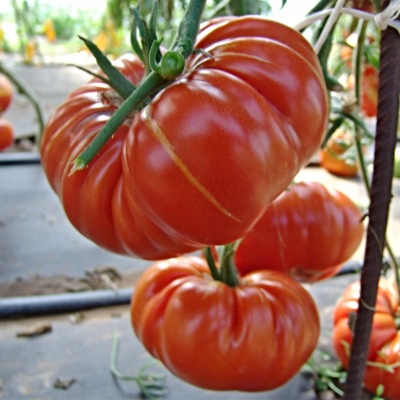
- Authors: MoravoSeed, Czech Republic
- Name synonyms: Brutus
- Category: grade
- Growth type: indeterminate
- Appointment: fresh consumption, for juice
- Ripening period: mid-early
- Ripening time, days: 105-115
- Growing conditions: for open ground, for film greenhouses
- Bush size: tall
- Bush height, cm: 180-300
Tomato Brutus can be enjoyed by even the most demanding gardeners. But before you start preparing seedlings, you need to familiarize yourself with it in advance. Only in this case it will be possible to insure against unfavorable surprises.
Breeding history
Brutus is a Czech variety of tomatoes. The developers gave it a synonym for Brutus - more precisely, under this name the culture is realized abroad. Most of the work was done by MoravoSeed.
Description of the variety
Brutus is a classic indeterminate tomato. It can be cultivated both in open land and in greenhouses. The bushes differ greatly in height, there are both 180-centimeter and 3-meter specimens. Regardless of this, they develop very powerfully.
The main qualities of the fruit
Ripe Brutus berries are very large and have a rich red color. Single tomatoes weighing 500 g are found constantly. Fruits that carry 1.5-2 kg are also quite frequent. Other points:
ribbing is very powerful;
there is a characteristic flattening;
the flesh is bright red.
Taste characteristics
The consumer properties of Brutus make it possible to use it both fresh and to obtain juices. The fruits of this plant are sweet and tasty. They are characterized by a firm, fleshy flesh. The scent also fully meets all expectations, and even exceeds them.
Ripening and fruiting
Brutus is a representative of medium early tomatoes. After the formation of seedlings, you can wait for the harvest in 105-115 days. Typically, the fruiting period includes:
July;
August;
September.
Yield
Fruit picking is awe-inspiring even for sophisticated gardeners. They are delighted with the opportunity to get 10 kg of berries per bush. But only with impeccable compliance with agricultural standards. The diameter of the fruit can be 20 cm.
The timing of planting seedlings and planting in the ground
The official description recommends placing seeds in boxes no earlier than March 1 and no later than March 15. If this rule is observed, the time for transplanting into open ground occurs in the second half of May and in the first 5 June days. It is worth remembering that the treachery of the weather is unpredictable. Gardeners must have a backup schedule ready.

Growing tomato seedlings is an extremely important process, because it largely depends on whether the gardener will be able to harvest at all. All aspects must be taken into account, from seedbed preparation to planting in the ground.
Landing scheme
Experts insist that it is best to plant Brutus in the order of 600x500 mm. Landing is allowed no more than 3 copies per 1 sq. m. With a greater thickening of the plantings, diseases may occur. And the tomatoes just start to interfere with each other. It is required to form plants strictly in 1 stem.

Growing and care
The variety is quite capricious. Without pinching, correct formation and a garter to the supports, he is not able to develop normally. Formation of bushes in 1 stem is recommended. Important: planting Brutus in glass greenhouses (unlike film greenhouses) is not recommended. The plant is resistant to shading, but it still manifests itself much better in very bright areas.
Seedlings can only be successfully obtained with the strongest and most decent seeds. Sow them to a maximum depth of 2 cm. Therefore, the first containers are not necessarily large. Transplanting into a greenhouse or into the open ground is allowed only after the soil has confidently warmed up to +12 degrees.
It is recommended to cover the seedlings immediately after transplanting to a permanent place. Return frosts are especially dangerous for young growth. The gap between the holes should be at least 0.4 m. It is advisable to make a row spacing of at least 0.7 m. Complex mineral mixtures, which are added by irrigation with an aqueous solution, are strongly advised.
The best feeding (per 1 m2):
60 g superphosphate;
60 g of potassium sulfate;
40 g of ammonium sulfate.
The planting material is disinfected in potassium permanganate for 20 minutes. Important: use only a weak solution of it so that the seeds are not damaged. It is advisable to put 30 g of seeded wood ash in each hole. It is necessary to tie up the bushes throughout the entire main shoot. It is necessary to graze a tomato throughout the growing season, otherwise, instead of a vegetable garden, you can see an "impenetrable tropical forest".




A plant needs different micronutrients at each stage of growth. All fertilizers can be divided into two groups: mineral and organic. Folk remedies are often used: iodine, yeast, bird droppings, eggshells.
It is important to observe the rate and period of feeding. This also applies to folk remedies and organic fertilizers.


Review overview
The Brutus variety is rated very highly by almost everyone who tests it on their site. Even in greenhouses without heating, the plant performs extremely well. The berries are really large and tasty. Cracking is almost impossible.The culture survives the heat well, which allows it to be successfully grown in the southern regions.

























































































